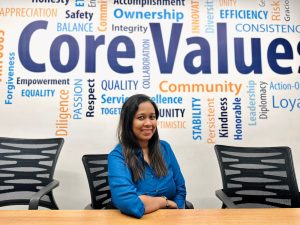
Esha Nair is an accomplished HR professional with 15 years of experience, and is currently serving as the Chief Human Resources Officer at Fermion Infotech. As a certified HRBP and PoSH Consultant, Esha has led the HR team at Fermion Infotech in pioneering innovative practices that emphasize employer branding and effective people management. Under Esha’s leadership, the team has developed HR policies that not only addresses the diverse needs of clients but also seamlessly integrate employee well-being with the company’s goals.
Recognized for a focus on sincerity and integrity, Esha has implemented tailored recruitment strategies that leverage expertise across various sectors. These efforts have significantly contributed to Fermion Infotech’s dynamic growth and reinforced its robust corporate identity, ensuring alignment with industry demands and driving organizational success.
In this Interview, Esha Nair shares her take on current & future Performance Management practices:
What are your predictions for the most significant trends in performance management and employee engagement in the coming years?
The future of performance management and employee engagement is all about agility and personalization. Annual reviews will be replaced by continuous feedback loops with regular check-ins and coaching. Performance management will focus on developing future skills needed to thrive in the ever-changing tech industry, with data playing a more prominent role in identifying areas for improvement and guiding decisions. Technology will further streamline processes, offering platforms for setting goals, providing feedback, and tracking progress. On the employee engagement front, well-being will be a top priority, with companies offering programs and benefits to support physical and mental health. Flexibility and autonomy will be key to attracting and retaining top talent, with remote work options and flexible schedules becoming the norm. Organizations will move towards creating more personalized work experiences, offering tailored learning and development opportunities, and projects that align with individual interests. Finally, a strong focus on purpose and meaning will be crucial. By clearly communicating the company mission and offering opportunities to contribute to something larger than themselves.
Do you see burnout to be a major problem in companies across industries currently and in the future? How do you think performance management and engagement can help in tackling this issue?
Employee burnout is a growing concern, but strong performance management and employee engagement strategies can be the antidote. Regular check-ins and clear communication help us spot warning signs early. Performance discussions can also ensure healthy work-life balance and targeted development programs boost confidence, reducing stress. Recognizing achievements and fostering open communication further strengthens employee well-being, preventing burnout and attracting top talent.
What advice would you give HR professionals on creating a holistic performance management strategy that integrates employee well-being and engagement?
For a winning performance management strategy, focus on development, not just past performance. Regular check-ins and coaching should address both skills and well-being. Ditch annual reviews for continuous feedback. Open communication helps identify issues, celebrate wins, and prevent burnout. Use data to track progress but prioritize qualitative feedback for a holistic view. Personalize learning and development to boost motivation and engagement. Make employee well-being a priority with programs that support physical and mental health. Regularly recognize achievements to reinforce positive behaviors and foster a culture of engagement. Finally, clearly communicate company goals and how individual performance contributes to the bigger picture. By integrating these elements, you can create a performance management system that fuels growth, well-being, and a highly engaged workforce.
According to you, how can companies leverage employee purpose and passion to drive top performance and create a more meaningful work experience?
Purpose and passion are the secret sauce for top performance and meaningful work. Clearly communicate the company mission and connect it to individual roles, so employees see the bigger picture and feel motivated. Empower them with ownership and decision-making to leverage their unique skills and passions. Fuel their passion with opportunities for continuous learning and development that align with both individual and company goals. Recognize and celebrate employee passion through public recognition, mentorship, or passion projects. Finally, create a collaborative environment where employees can share ideas, learn from each other, and support one another’s growth. By following this, we can create a workplace where purpose and passion thrive, leading to a more engaged workforce, higher performance, and a truly meaningful experience for all.
How would you recommend handling a situation where a high-performing employee suddenly shows a decline in performance?
A sudden performance dip from a star employee deserves a caring approach. Schedule a private meeting, listen actively, and avoid blame. Together, you can uncover the root cause, be it personal challenges, workload, or skill gaps. Develop solutions like support programs, workload adjustments, or training opportunities. Regular check-ins will ensure they get back on track.
How do you create a work environment that encourages employees to take risks and innovate, knowing that failures will be addressed constructively?
Psychologically safe environment is key. Employees need to feel comfortable taking risks and sharing ideas without fear. Open communication and active listening from leadership are crucial. Embrace calculated risks. Encourage experimentation within reasonable boundaries. Set clear goals but allow flexibility in how they’re achieved. Focus on learning from failures, not punishment. Conduct constructive post-mortems to identify areas for improvement and encourage knowledge sharing. Recognize and reward innovation, big or small. This reinforces risk-taking and inspires others.